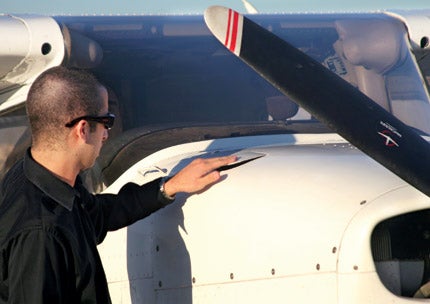 It has been said that oil is the blood of an engine. If the oil is old and tired, contains foreign materials or flows at the wrong pressure, the engine’s optimum life span can be threatened. All pilots should know enough to check oil quality, as well as quantity, during preflight inspection. A quick peek at oil quantity marks on the dipstick isn’t enough. During preflight, you need to determine whether the oil seems suspiciously gritty, displays an unusual color or sheen, seems too thin or too thick for the ambient temperature, or has a “burnt” aroma. Inspect inside the cowling and on the ground under the engine for signs of oil leaks. And, for security, check whatever parts of the oil system may be visible, including hoses, the oil cooler and the filler pipe. To avoid having your lengthy preflight become a waste of time that creates, rather than prevents, a hazardous condition, you also need to make sure that you’ve secured whatever you opened for inspection. Take, for example, the following accidents.
It has been said that oil is the blood of an engine. If the oil is old and tired, contains foreign materials or flows at the wrong pressure, the engine’s optimum life span can be threatened. All pilots should know enough to check oil quality, as well as quantity, during preflight inspection. A quick peek at oil quantity marks on the dipstick isn’t enough. During preflight, you need to determine whether the oil seems suspiciously gritty, displays an unusual color or sheen, seems too thin or too thick for the ambient temperature, or has a “burnt” aroma. Inspect inside the cowling and on the ground under the engine for signs of oil leaks. And, for security, check whatever parts of the oil system may be visible, including hoses, the oil cooler and the filler pipe. To avoid having your lengthy preflight become a waste of time that creates, rather than prevents, a hazardous condition, you also need to make sure that you’ve secured whatever you opened for inspection. Take, for example, the following accidents.
⢠A Cessna 150M with a student pilot on board was substantially damaged during a forced landing attempt. The flight originated at Grand Ledge, Mich., and was en route to Mount Pleasant, Mich., in day/VFR conditions.
In a written statement to investigators, the (uninjured) student reported being approximately four miles from Mount Pleasant Municipal Airport when the airplane “started to shake violently and the engine rpm dropped to 1,500.” The pilot moved the mixture control to rich, turned on the carburetor heat and performed his checks, but “couldn’t find anything wrong.” He contacted Saginaw Approach and informed them that the airplane “was having engine trouble and was losing altitude.” The pilot also told the controller that he thought he “could make the field” and that he “had the airport in sight.” The pilot changed radio frequencies to Mount Pleasant Unicom and informed the airport traffic that he’d be making an emergency landing on runway 09. As the pilot turned toward the airport, the engine rpm dropped to 1,000, and the airplane began to lose altitude rapidly. The pilot performed a forced landing on the airport grounds, 400 feet short of the runway 09 threshold. When the nosewheel touched down in the snow-covered ground, the airplane “stopped suddenly and pitched forward on its nose.”
An FAA inspector reported that oil was covering the engine cowling. Further examination of the engine revealed that the connecting rod to the number-one cylinder had failed due to oil starvation. The oil cap to the crankcase was found to be loose. Oil was observed covering the left-side engine components in the area of the oil filler neck.
The NTSB determined that the probable cause was the student’s inadequate preflight and a loose oil filler cap, which resulted in oil starvation and failure of the number-one cylinder connecting rod. The pilot had 34 hours with 32 in type.
⢠A Cessna T210L was destroyed when it impacted the ground near Richard Lloyd Jones Jr. Airport in Tulsa, Okla. Two passengers and the instrument-rated private pilot were fatally injured. Day/visual meteorological conditions prevailed for the cross-country personal flight. The flight’s destination was Joplin, Mo.
After taking off from runway 19R, the pilot was instructed to turn to a 100-degree heading. About a minute and 40 seconds later, the pilot reported that he had oil on the windshield and wanted to return to the airport. A pilot who was taking off behind the aircraft said that it leveled off at 300 feet, slowed down and made a right turn back toward the airport. He said that the T210L started the right turn to the north and “appeared to be moving very slowly.” As the airplane turned through a heading of about 300 degrees, the right wing dropped, the airplane rotated three-quarters of a turn to the right and it struck the ground. A fire broke out.
The pilot had approximately 1,474 hours of flight experience with 794 hours in the accident airplane.
The engine’s oil filler neck was found without its cap, which was attached to the neck by a chain and was found undamaged between two of the engine’s cylinders. Windshield pieces found beyond the fire zone were coated with oil. According to the engine manufacturer, the engine could probably run for 15 to 25 minutes without a cap on the filler neck.
The probable cause was determined to be the pilot’s inadequate preflight inspection and his failure to secure the oil cap. This resulted in oil leakage on the windscreen, which obstructed his vision and led to his failure to maintain adequate airspeed.
⢠A Cessna 182C was substantially damaged when it collided with terrain while maneuvering for a precautionary landing at the Carson Field Airstrip in Marion, Mont. The certificated commercial pilot and all four passengers were killed. Day/VFR conditions prevailed for the skydiving flight. The flight took off about five minutes before the accident.
A witness saw the pilot perform a preflight inspection prior to departing on the first flight of the day. This included checking the oil and fuel levels. The pilot pulled out and then checked the dipstick, but the witness didn’t see him remove the oil filler cap or add any oil to the airplane. The airplane’s engine had separate openings for adding oil and checking oil level.
Another witness saw the airplane take off heading north, and a minute or so later, she heard the sound of an airplane descending. The witness reported, “I looked up to see him approaching [runway 32] on his base leg, too low to make a safe turn to final. I continued to watch him as the aircraft rocked slightly, then appeared to take a sharp left turn, causing the nose to dive downward.” The witness said the left wing slightly dipped, and the airplane crashed. The commercial pilot had accumulated a total of 508.5 flight hours with 46 hours in make and model.
An examination of the engine revealed that the oil filler cap was detached from the oil filler tube. It was hanging by its chain between cylinders four and six. The cap wasn’t damaged.
A weight and balance calculation indicated that the airplane was approximately 165 pounds over its max gross weight, and the center of gravity was at or near the aft limit at the time of the accident.
The NTSB reported that because the oil filler cap wasn’t secured to the filler tube, it’s reasonable to expect that oil would have escaped the engine and blown back over the pilot’s windscreen, thereby obstructing his vision. The obstructed windscreen, coupled with the airplane’s excess gross takeoff weight, would probably explain the pilot’s loss of control.
The NTSB determined that the probable cause was the pilot’s failure to maintain aircraft control while maneuvering to reverse direction. Factors included the airplane exceeding its max gross takeoff weight, the improper preflight in which the pilot failed to secure the oil cap, the low altitude and an obstructed windshield.
⢠A Piper PA28R-201T, which originated from Watkins, Colo., was destroyed when it struck a fence during a forced landing near Hartsel, Colo. The pilot and passenger escaped injury. Dusk/VFR conditions prevailed.
The pilot told investigators that shortly after sunset, he was in cruise flight when oil began to appear on the windshield. He pulled back the throttle to idle, then slowly added some power. He didn’t notice “any substantial response” from the engine, but did observe more oil on the windshield. He slowed the airplane to 100 knots, then determined that the nearest airport, Buena Vista, was about 21 miles away. He didn’t think he could make it, and elected to land on a dirt road. He said approach speed was 10 knots higher than normal “to avoid obstructions.” He realized he was going too fast and would overshoot the road, so he turned to an adjoining field. He maneuvered the airplane over a herd of buffalo and touched down. During the landing roll, the airplane struck a fence, rupturing the right-wing fuel tank. Fire department personnel later discovered the oil filler cap was missing.
The airplane was moved to a facility in Greeley, Colo. The oil access panel on the cowling was opened and the dipstick was removed. It registered three quarts of oil. The pilot said he “thoroughly preflighted the airplane” and checked the oil. The oil level was “about one-third down from the top” (about six quarts; capacity is eight quarts). The pilot said the oil filler cap, which was next to and behind the dipstick, “was easily visible and in place,” but he didn’t physically check it for security. The oil filler cap was eventually located in a recess atop the right bank of cylinders where it had fallen.
The probable cause was determined to be the misjudgment of the proper touchdown point on the dirt road due to excessive airspeed and failure to deploy flaps. Other factors included the partial loss of engine lubricating oil, which resulted from the oil filler cap departing after an unknown person failed to properly secure it, and an inadequate preflight inspection.
Peter Katz is editor and publisher of NTSB Reporter, an independent monthly update on aircraft accident investigations and other NTSB news. To subscribe, write to: NTSB Reporter, Subscription Dept., P.O. Box 831, White Plains, NY 10602-0831.




